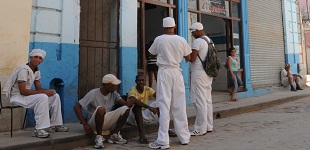
Accommodation
While in Cuba, we stayed only in Casas Particulares, which as we mentioned before, are homes where the owners are able to rent out rooms to guests. These were far cheaper and more personal than
hotels. The family there usually follows your lead as to whether to stay out of your way, or to chat. We stayed in 5 in all, 2 in Havana, one in Trinidad, one in Santa Clara and one in Cienfuegos. They were all good quality, and
the rooms ranged from 20 to 25 Cuban convertible pesos per night (about 13 to 18 GBP at the time). Breakfast is always available, and lunch and dinner if requested. Given the quality of restaurant food was often questionable, meals
in the Casa were not a bad choice.
By far the best one we stayed in was the Casa del Chef in Havana. The owners, Rolando and Marisol, were pretty much friends by the end of our stay, and I suspect that we weren’t the only guests that ended up with that kind of relationship
with them. Rolando is a giant of a man with a great line in banter, humour and teasing. Marisol has one of the biggest hearts especially for children.
On the third day, they took our four children to the park to play to give us a break. They washed our clothes without asking for payment (which the other Casas did). When we unexpectedly had to stay in Havana for 2 unplanned nights
thanks to the eternally unreliable Cubana airlines, they called around and found us another Casa as they had no room. When they saw my struggle to take our double pram up their narrow stairs, they started to lower it and raise
it to us from their balcony with a rope. And when they saw that it was taking a while to undo the knot on the rope, then they used a hook instead. The last day we wanted to get our hair cut, but as the barbers were closed as it
was a Sunday, they got him in to their house to do it for us. I would without hesitation recommend them for anyone staying in Havana, and as Rolando was previously a chef, the food was always good. Their email is vista9@nuestrocorreito.com,
phone is 866 5805, and their address is Calle Merced No. 60, entre San Ignacio & Cuba, Habana Vieja. If you are looking for accommodation in Havana, you may find a more luxurious house, but you won’t find better hosts. And
that makes all the difference.
In Trinidad, there is a huge selection of Casas. We, and everyone else, were hounded by touts and taxi drivers wanting to take us to the house that pays them commission. We met a couple of people who had booked somewhere, but were
taken somewhere different by the taxi driver as it was a house that would give the driver commission. If you are stern and tell them that you’ve booked and paid, the drivers generally would not try to rip you off, and would take
you to the right place. If you are looking, try to find a colonial house, as these can be stunning. If a Casa is booked, ask the owner for another recommendation – they all know each other and will be very helpful here, but make
sure you ask what type of a house it is and where it is.
Cienfuegos. Decide whether you want to be walking distance from the beach, in which case find a Casa in Punta Gorda, or in the town, in which case find a Casa there. They aren’t too far from each other, but far enough to make it easier
if you’re with a family to stay in the right spot. That said, a bus ride between the two will set you back a whole 20 centavos, which is about 0.6 pence at the time of writing. And the best beach in the area will need a cheap cab
ride to Rancho Luna.
Food
Cuban restaurants served the same variation on a theme in most places. Rice, fried banana, yuka where we could get it, salad with a choice of shrimp, lobster, chicken or pork. There were about three price
points, 2/3 Convertible Pesos, 5/6 Convertible Pesos, or 8/10 Convertible Pesos. The quality of restaurant food we had was generally not great, and bore minimal or no correlation to price. The shrimps were usually reliable, the
lobster was often good, and the chicken less so. Never tried the pork, so I can’t comment! Menu prices in a few places were open to negotiation.
In Havana, the Jardines del Orient, which was at the lower price bracket, was good, and had a nice garden setting just of the Plaza Vieja. The Medina is to be avoided at all costs, as the food was really not good, and was also pricey.
Pizzeria Romana in Santa Clara served up the worst lasagne I’ve ever had, and the pizza was not much better, though all was cheap! The best meal by far in Cienfuegos for us was actually just outside the town on the way to Trinidad.
I don’t think the restaurant had a name. It was a house with about 3 tables on the patio for guests, and rustled up the same menu as above, but really cooked well (home style), and in good portions. And it cost about £12 to feed
3 adults (we treated the taxi driver as he was such a good guy) and 4 children. Call Rafael the taxi driver (01-53417398) and ask him to take you there. In Trinidad the restaurateurs and their various agents were incredibly pushy,
but the best (and priciest) meal we had was in the Trinidad Colonial, which also had good musicians and great waiting staff. Again, try out the cooking at the Casa if you’re staying in one, as it’s often better than the restaurants.
Travel
Metered taxis are run by salaried employees, and give you the reassurance of a metered fare. Tip these guys – they need it. Private taxis, often in the old American cars, are usually private enterprises
and quote a fare which you can negotiate. We used these a lot more, as the size made them better for our family of 6. They are also a unique experience, especially for longer trips. In Havana, Jesus on 01- 52838359 was reliable
as clockwork in his 1950s Oldsmobile. Rafael, who we mentioned before, was fantastic in Cienfuegos and a lovely man with a lovely wife, and is on 01-53417398. He also had a family friend, Oswaldo, take us from Cienfuegos to Trinidad,
who was again great and made a 2 hour beach stop on the way for our kids to okay without charging extra.
We also used the Viazul buses on longer treks. These were comfortable, air conditioned and generally very on time. Cheaper than taxis, except for larger families, and recommended. Check their website for times and prices.
Every experience we had with Cubana airlines was a bad one. The fleet is ageing, and often has problems, and 3 flights we had were delayed significantly. We’d not use them again when we go back to Cuba.
Bicitaxis were great. Cheaper than cars, often more fun especially for banter with the riders. Fares always negotiable, and walking away always worked to get the prices we wanted. These are all run as personal enterprises as far as
we could make out.
Cocotaxis in Havana were great fun for the kids. These look like large yellow eggs opened at the front for the riders to get in. They are actually Vespa mopeds with the body built around them. Again, salaried employees, though rates
are negotiable.
[album: https://oursouthamericablog.com/wp-content/plugins/dm-albums/dm-albums.php?currdir=/wp-content/uploads/dm-albums/Cuba Travel Tips/]
Internet
Minimal wifi (2 hotels in Havana, the Parque Central and Saratoga, none in Trinidad, Cienfuegos or Santa Clara). Limited terminals in ETECSA facilities or hotels, though sometimes you need to be a resident
to use them.
Where we’d go back to if we come back
Havana for sure. So much more to see and experience. Trinidad is fantastic for the music, the art, the buildings. But also the most hassle in the streets touting for business,
and the only experience we had in Cuba of begging. Regardless, an awesome city well worth a revisit. Less so Cienfuegos, which was a disappointment to us after the build up it had from the locals. Santa Clara is definitely worth
a visit for the Che memorial and museum, but one visit for one day was enough for us. We’d also try Santiago, Guantanamo and Varadero next time if we can.
Book
The Lonely Planet. Every time.
Worth it?
Hell, yes. Fantastic people, great history, very different from Europe / US. Incredibly child friendly, and always ready for a chat. We’ll definitely be going back if we get the chance.



















Hi Guys,
Great time is beinbg had by all. Glad that Alvaro has developed this great admiration on such a powerful hero. Your story has inspired me to enlighten my son on Che.